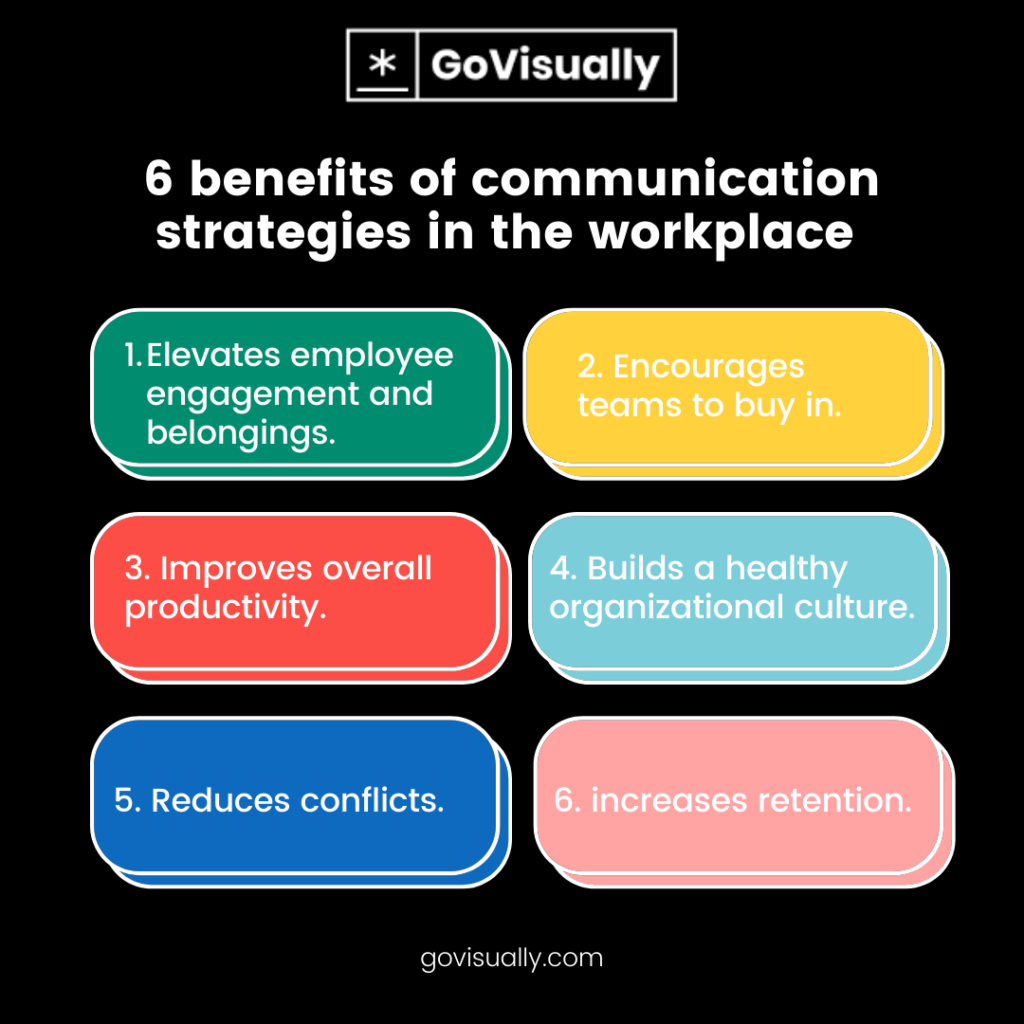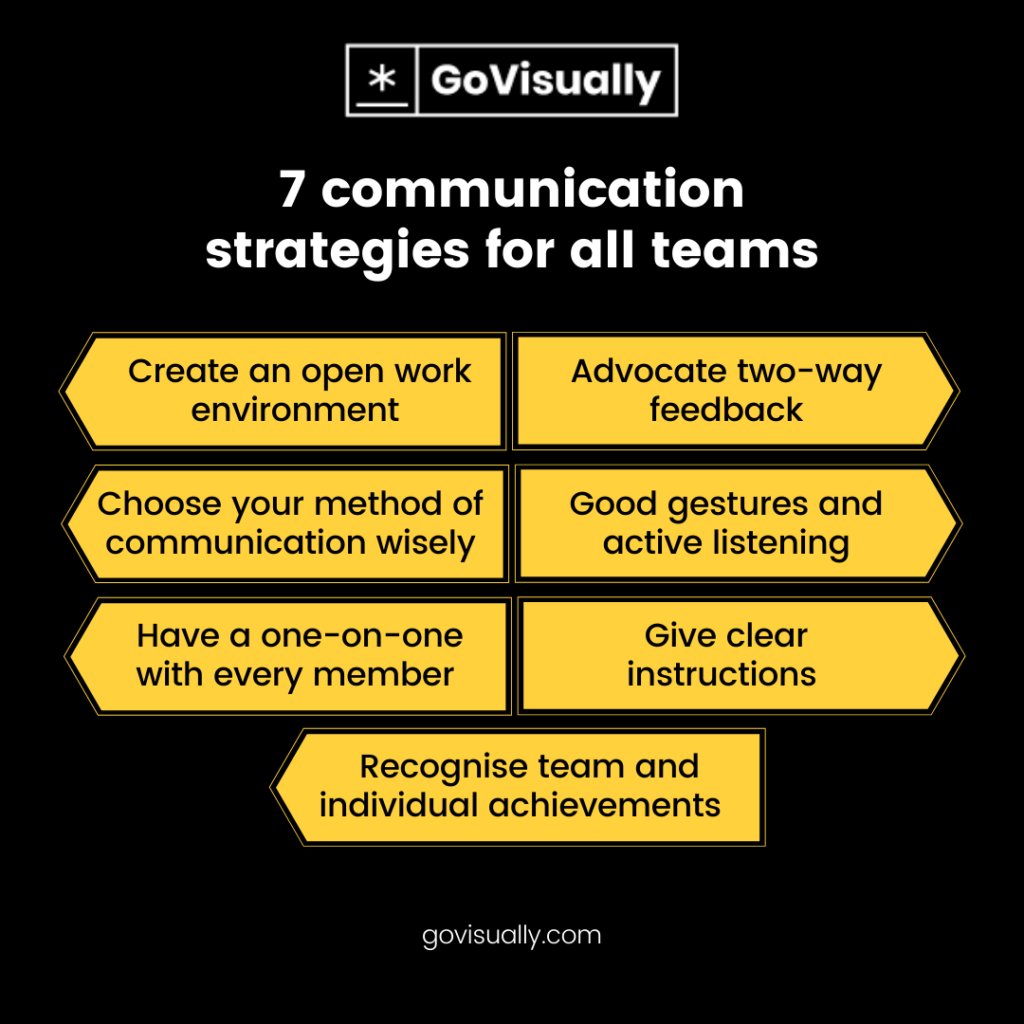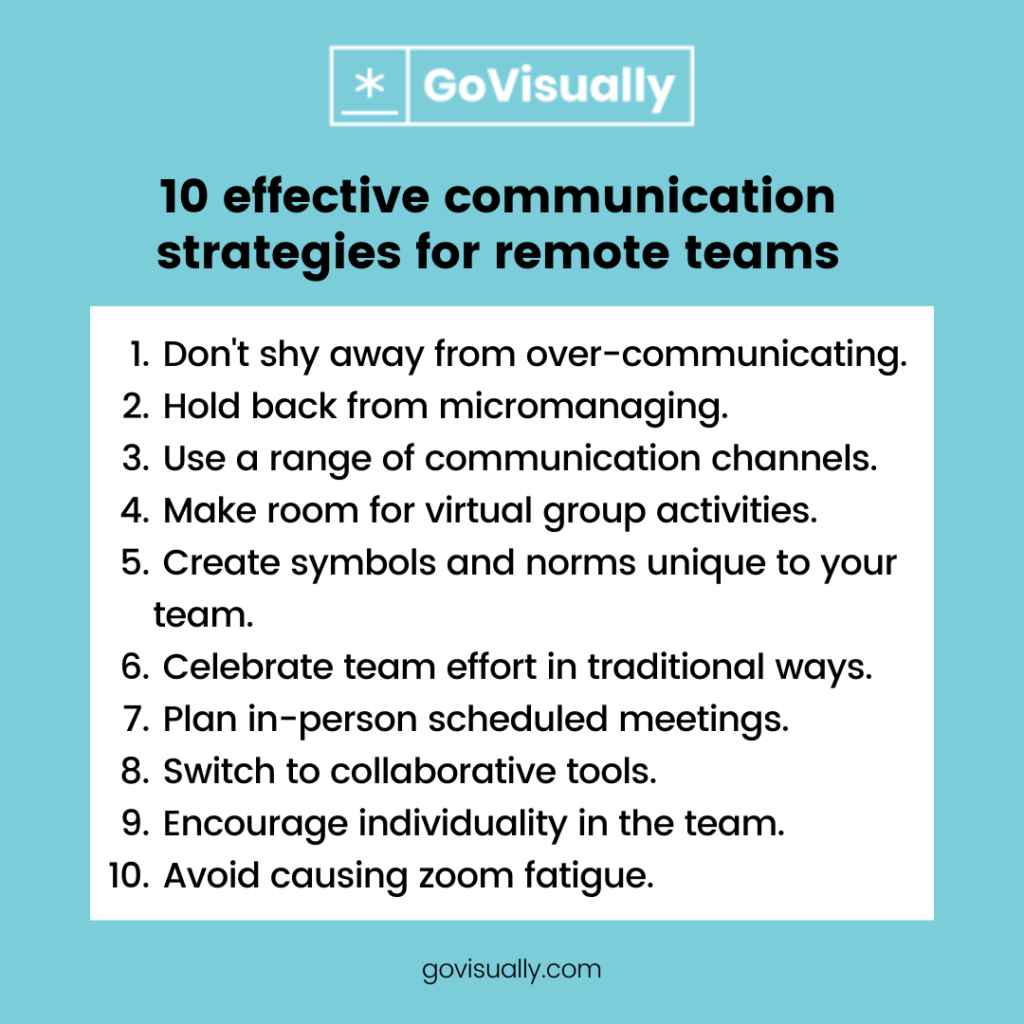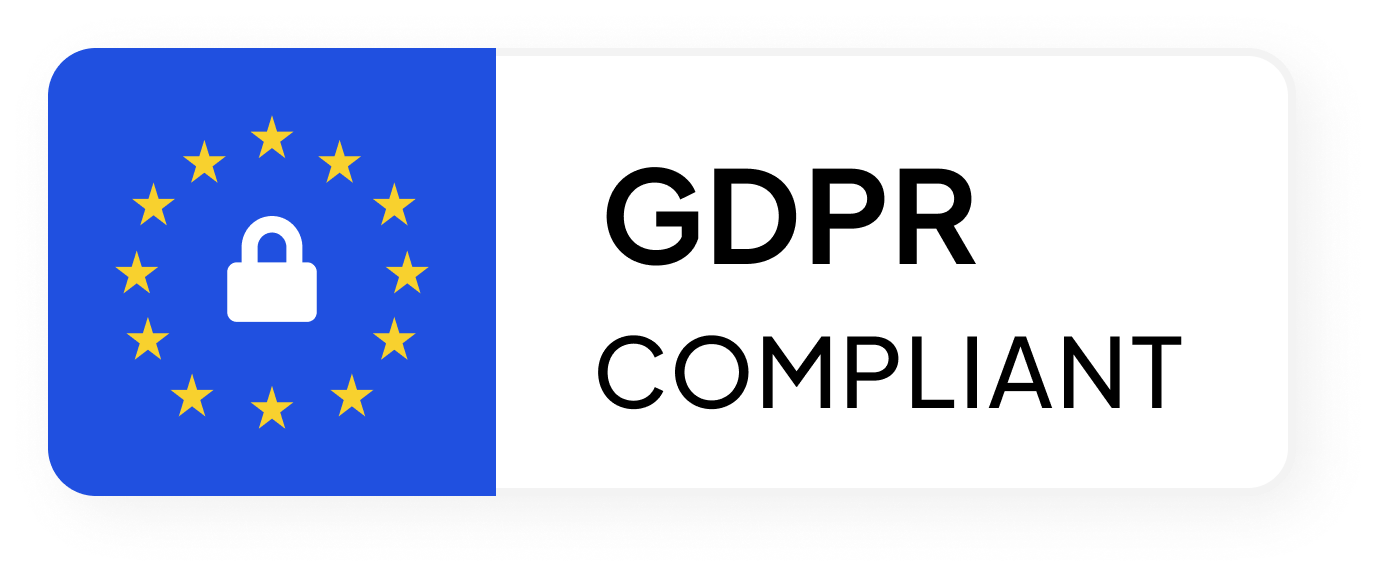Humans are social animals.
How many times have you heard this saying?
A bunch, right?
That’s because the essence of being social lies in communication. And thanks to effective communication, we’ve come a long way from being hunter-gatherers to technological evolution.
And that is why, to advance your career, you need an effective communication strategy in the workplace. It ensures that the workflow is in the right direction, all employees are on the same page, and team efficiency is at its best.
So if you’ve been wondering what communication strategies you should implement for your team, we’ve heard you!
This article will discuss the top 17 communication strategies for all teams (and specifically for remote teams too).
Let’s get started!
Table of Contents
Communication strategies definition – what exactly is effective communication?
To implement effective communication, you need to understand what it means. There’s heaps of information on what communication is, but it often fails to outline how communication effectively occurs.
How do we even define what effective communication is?
Effective communication is a process of conveying ideas, thoughts, knowledge, and information. The purpose is fulfilled in the best possible manner, and the sender’s intention is mirrored clearly to the receiver.
Consequently, by definition, communication strategies ensure that effective communication occurs. Knowing which strategies fit best to your team is a matter of trial and error and understanding your unique team dynamics and work models.
Another key difference is between ‘communication’ and ‘workplace communication.’ Yes, the strategies in both cases overlap. However, communication strategies for the workplace are tailored to enhance team performance to its true potential.
In this era, technological advancement has made it easier to communicate. On the contrary, the drawback here is that it has also become more difficult to discern between the important and less important parts of what’s being communicated to us. Especially in workplace scenarios, a comprehensive communication strategy is indispensable.
How are communication strategies in the workplace different?
Workplace communication would generally include any means of communication you use at work. Daily reports, feedback sessions, sharing group tasks, communicating individual tasks, and discussing a shared goal.
Workplace communication has become more diverse since we no longer use conventional means of communication as much as we used to. It can occur in person, in writing, through video conference, or in a group meeting.
Now more than ever, it happens asynchronously, for example, when you’re communicating about work through email, a recorded video, or using platforms like a project management tool or communication tools.

Prior discussions about communication strategies in business assumed the “workplace” to be in person. Now, as we stand, there are multiple ways to communicate across different locations – from global workspaces to remote teams. Most communication strategy examples still apply to any team, but there are a few additional practices you can use specifically to help remote team members truly connect.
You have probably gotten the nuance of it all. Now it’s time to dive into the most effective communication strategies.

1. Create an open work environment
The first step of your action plan toward great communication is creating an open environment for your employees. Most of us are at times hesitant to share our thoughts and opinions openly, it becomes more daunting in front of a manager. It’s also an essential step toward building trust and reliability among individuals.
Make sure your team can rely on you to listen when they need to be heard. To open the flow of communication, make sure your team is comfortable enough to come up and ask about their problems, mistakes, and any questions to clear their confusion.
2. Have a one-on-one with every member
Usually, there’s much left unsaid in group meetings, where you only outline organizational and project-specific goals. The more purposeful your interactions are with your team members, the better they will perform on their tasks.
One-to-one communication is a great source of these purposeful interactions. You can be more candid about your team members’ performance and areas they’re struggling to grasp and clearly state your expectations and needs as an individual. Your employees may also bring into light the suggestions or issues they could not comfortably bring up in a group setting.
3. Advocate two-way feedback
This is one grave mistake that managers and leaders often make; they turn feedback into a one-way dialogue. It’s necessary for team leads to maintain two-way communication. Effective communication takes place when both sides are equally heard.
Managers can use this opportunity to improve their communication, leadership, and management style. Meanwhile, a two-way feedback process will also encourage employees to self-evaluate and build better pathways for organizational success.
4. Choose your method of communication wisely
Recognizing the importance of being deliberate while choosing your mode of communication is just as essential as having good communication skills. Write what needs to be written, show what needs to be shown, and tell what needs to be told. Don’t hesitate to use big visuals, infographics, and anything that would assist your team in remembering the details and retaining more information – especially when most of us are straight-up bad at retaining auditory information for longer terms.
It would be better to incorporate more than two methods from the following during the communication process:
- Visual communication – via images, infographics, videos, and illustrations.
- Verbal communication – via calls, recorded tutorials, face-to-face, or any form of media.
- Non-verbal communication – through body language, gestures, and eye contact.
- Written communication – via documents, emails, texts, and online threads of relevant information on tasks.
5. Good gestures and active listening
Effective communication is not only about direct modes of communication but also peripheral ones, like non-verbal cues. The art of body language is knowing how to use it to your benefit. Your gestures convey what your words do not. Employees who practice active listening retain more information and perform better.
Don’t just sit back and let the words go over your head. Make eye contact with the person speaking, listen with intent, respond appropriately, and don’t interrupt until it’s your turn to speak. Use facial expressions to convey agreement, delight, and other appropriate emotions, but be careful how you use them.
Being a good listener is just as significant as being a good speaker. The same goes for team leads and managers; employees feel more inclined to engage actively in communication when they listen intently. Keeping a positive and persuasive stance during discussions also helps you sound more confident and charismatic.
6. Give clear instructions
A jumble of words and an influx of unrefined data will leave anyone confused and gasping for air. The more complex you make your instructions sound, the harder it will become for your team to put them into effect.
Keep your program-specific instructions concise, organized, and easy to understand. It goes hand in hand with choosing appropriate methods of communication. You can use project management tools, emails, video conferences, or all of these at once to organize instructions effectively so your team can get it right the first time.
The best way to avoid creating long threads of unorganized emails, getting the edited versions of a file mixed up, or failing task completion due to poor instructions is to shift project management with team collaboration and review software.
If you’re looking for the best online review and approval software, GoVisually‘s got your back!
You can use it to better organize/manage your creative projects. And more importantly, get feedback on it in real-time until completion.
7. Recognise team and individual achievements
Everyone wants to be recognized for their hard work. There have been several studies outlining the importance of rewards in a workplace. You can choose monetary, non-monetary, assistance-based, or recognition-based rewards for your employees to complete tasks depending on the project’s nature or organization.
Regardless of which, giving your employees the much-needed praise has proven to make them more motivated to work and improve for the better. This will contribute to team cohesiveness and lead them towards better communication naturally.
This concludes our strategies to improve communication in the workplace.
Moving on to a more relevant communication affair between remote teams, more specific strategies are ahead!
10 effective strategies to improve communication within remote teams
Communication strategies in business are essential in general. Still, they are more crucial when teams collaborate remotely because, as George Bernard said, the single biggest problem in communication is the illusion that it has taken place.
The three greatest challenges associated with remote work are:
- Unplugging after work (22%)
- Loneliness (19%)
- Communication or collaboration (17%)
We have compiled a definitive application guide of communication strategies to assist businesses in achieving the true potential of their remote teams by tackling all three challenges at once.

1. Don’t shy away from over-communicating
Be as elaborate as you can. Instead of being concise to save time and leaving ambiguous grounds to create confusion, it’s better to go overboard when communicating important details or instructions. Hence, the key messages never fail to get across.
There’s room for misinterpretation and miscommunication with virtual contact because we miss an integral part of social interaction. There is a mental strain on individuals to get the details right with limited information, so it’s better to explain more rather than less at any given opportunity. It’s more productive to use video conferencing to ensure your team is on the same page.
Additionally, since remote work is mostly dependent on emails and written documents, writing detailed emails and instructions is a way to ensure enough has been conveyed. You can also set up a thread for every project using online platforms to make answering questions and keeping records easier for your team from the beginning.
2. Hold back from micromanaging
Give your team the space it deserves. Have faith in your team with the tasks they are handed rather than ringing them up every minute using all communication channels. It’s counterproductive to receive the same reminder in an email, again in a personal chat, and even worse through a call. Everyone will get agitated.
Your team comprises responsible adults who know self-discipline, especially when they have experienced work remotely. It’s better to use progress trackers or excel checklists to stay updated and let your inner perfectionist hold back from checking up on everyone and sending too many consistent messages. It will make them feel trusted.
3. Create symbols and norms unique to your team
The versatility in communication strategies may not be evident in person, but it is in virtual conversations. Every person communicates differently; let your team have the freedom to interact with minimal formalities when collaborating to be themselves. It’s easier to connect when you’re genuine and consistent in your interactions.
Creating communication norms can range from making acronyms for digital exchanges to color or letter indications. For example, NRN (no reply needed) or 4HR (4-hour reply). Signifying the nature or urgency of the conversation can bring predictability and certainty to the parties involved.
4. Use a range of communication channels
Utilizing different communication channels can easily divide necessary communication and periphery communication. You can use platforms like Slack for creating task-specific group chats where your team can smoothly interact.
This will also allow your team to cool off their work stress by having candid conversations and light-hearted exchanges similar to how people interact in person. Encourage one-on-one communication between remote employees so they can get friendlier and have a greater affinity.
5. Make room for virtual group activities
Guide your team to fulfill their inner socializers by creating a team forum, conducting virtual game breaks, or having them interact in video sessions for conversations other than work.
Having weekly group activities or video chats to mingle can assist remote employees in getting rid of their burnout and the feeling of isolation. Please use online gaming platforms for board games, or scavenger hunts your team can take part in to help them recharge while increasing rapport.
6. Celebrate team effort in traditional ways
Sending out cards or certificates to celebrate a success or event would be useful in keeping the team engaged and having representation of the company culture. Virtual celebrations can be good; however, try not to replace tangible awards with virtual ones because they add more meaning and value for individuals.
Another way to implement this is to make new traditions, such as wishing birthdays by sending presents or celebrating them in a video call. This will make your employees feel recognized as individuals and motivated to work well in the future.
7. Plan in-person scheduled meetings
Have your team interact in person once in a while for a purpose. Prepare these meetings to focus on a goal so they can bring a sense of association as being part of the company. It can help with their productivity, motivation, and building trust.
Setting aside the convenience and productivity of working remotely, in-person communication is essential for everyone to feel connected.
A study of 1,100 employees by the Harvard business review showed that remote employees feel isolated compared to on-site workers, which affects their productivity and commitment to work. Better take note of these communication strategies for remote teams!
8. Switch to collaborative tools
From feedback on Google Docs to personalized team group channels on Slack and project-specific task-management boards on Trello, give your team a field where they can share and collaborate more efficiently.
Unlike attached files on emails, collaborative tools can help check the progress of a project, answer relevant questions along the way, and exchange information faster, all in one place. It’s relatively easier to track a whole project from start to finish when everyone is sharing their end of the deal in the same place.
Collaborative tools also promote teamwork and feedback when everyone can share their opinions collectively and discuss the issues they might be facing. You can also check the best collaborative tools for productive remote teams to make things easier.
9. Encourage individuality in the team
We all value our individualism. It is easier to demonstrate our opinions and interest in real-time through our behaviors, working remotely could make your employees believe they’re not being seen or heard enough.
Organize group discussions, introductions, and get-to-know sessions, especially for recruits so all team members can have a chance to share their opinions and interests with others.
10. Avoid causing zoom fatigue
Constant video conferencing can cause zoom fatigue.
This phenomenon was recently discovered when virtual meetings were the only, yet newfound source of remote team collaboration. No matter how convenient video conferencing is, it’s wise not to overdo it.
As we suggested earlier, dividing the use of communication channels based on purpose is less of a hassle.
Cut design & video review time in half
Try GoVisually free today!
Barriers to implementing communication strategies in the workplace
There are some common barriers that hinder the process of communication no matter how great your strategies might be. Most of these issues can be categorized into three groups. Make sure to timely identify and eliminate such barriers, so all that effort put into good communication doesn’t go to waste.
Such barriers are at the core of most ineffective communication taking place. However, tackling them isn’t all that hard as long as you’re able to pinpoint them and assist your team in overcoming them together.
4 barriers of words in the workplace
The biggest role in communication is played by words. Any error, distraction, or disturbance in the words being conveyed can lead to even bigger miscommunication.
Language
Making excessive use of jargon and complicated terms.
Ambiguity and overuse of abstractions
The message being conveyed is vague or involves the use of abstract notions to explain simpler ideas.
Disorganized message
The words being used are not systematically organized, cohesive, or form a powerful message.
Information overload
Too much is said in a shorter amount of time without letting the receiver process it.
4 barriers of backgrounds in the workplace
In a group setting, everyone belongs from a different culture, educational level, gender, etc. all these factors contribute to a difference in experience, understanding, and opinions. Failing to place your team on a similar wavelength can be damaging to the cooperative nature of a team.
Attitudinal differences
It’s a part of human nature to be rigid when presented with new ideas. This rigidness in team members can obstruct the flow of communication.
Demographic differences
Differences in age, gender, status, etc., can lead to a lack of understanding among the group members.
Lack of common experience or perspective
It’s difficult for everyone to relate to an experience they have never gone through first-hand. It can often than not become difficult for a receiver to interpret a message that stems from the sender’s experience.
Jumping to conclusions
The absence of patience and the ability to listen actively can lead to members deriving their own conclusions without consultation.
3 physical barriers in the workplace
Such barriers can be special to your team circumstances, only be experienced by one individual of the team, or exist directly related to your workspace. These can be difficult to overcome but doing so should always be your priority.
Physical distance
The basic barrier faced by remote teams is the lack of behavioral and environmental cues when communicating.
Noise
Unwanted noise from the environment or the communication system disrupts the flow of communication making it ineffective.
Physiological impairments/disabilities of team members
A common barrier can be a physical disability. For example, hearing impairment or poor eyesight, etc.
Final takeaway
Ineffective communication leads to many unforeseen circumstances in our life every day. In a work setting these circumstances can lead to disastrous results, like losing projects, turnover, and an overall drop in organizational productivity.
In the end, the most important part is to understand that with digital evolution, virtual communication is no longer much different from in-person meetings. As long as everyone feels heard and seen, and has empathy and recognition your remote team will eventually become more dynamic and connected.
Do let us know if you find these strategies helpful.
Want to send big files?

Need a quick way to share large files and creative assets?
With GoVisually Share, it’s absolutely free! Try today.




